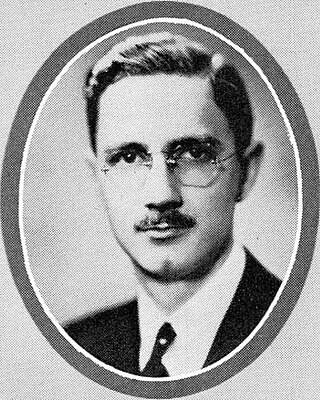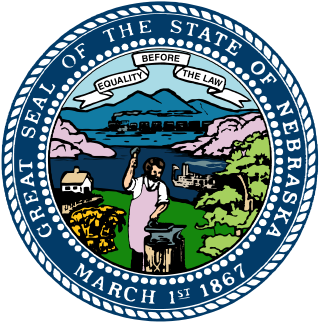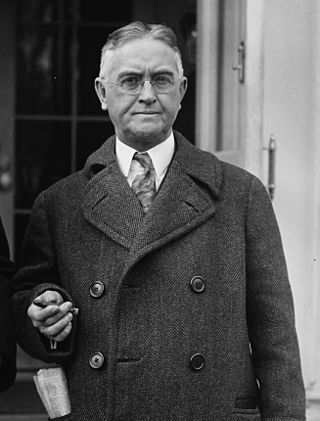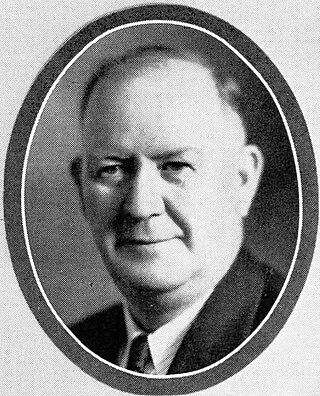| |||||||||||||||||
| |||||||||||||||||
| |||||||||||||||||
| Elections in Nebraska |
|---|
 |
The 1934 Nebraska lieutenant gubernatorial election was held on November 6, 1934, and featured incumbent Nebraska Lieutenant Governor Walter H. Jurgensen, a Democrat, defeating Republican nominee Charles W. Johnson. [1]
| |||||||||||||||||
| |||||||||||||||||
| |||||||||||||||||
| Elections in Nebraska |
|---|
 |
The 1934 Nebraska lieutenant gubernatorial election was held on November 6, 1934, and featured incumbent Nebraska Lieutenant Governor Walter H. Jurgensen, a Democrat, defeating Republican nominee Charles W. Johnson. [1]
| Party | Candidate | Votes | % | |
|---|---|---|---|---|
| Democratic | Walter H. Jurgensen (incumbent) | 134,218 | 78.51 | |
| Democratic | John A. Guttery | 36,747 | 21.49 | |
| Party | Candidate | Votes | % | |
|---|---|---|---|---|
| Republican | Charles W. Johnson | 45,272 | 31.89 | |
| Republican | C. A. Green | 29,613 | 20.86 | |
| Republican | Harvey L. Webster | 29,252 | 20.60 | |
| Republican | Stanley Wright | 21,062 | 14.83 | |
| Republican | Lewis C. Westwood | 16,778 | 11.82 | |
| Party | Candidate | Votes | % | |
|---|---|---|---|---|
| Democratic | Walter H. Jurgensen (incumbent) | 295,684 | 56.68 | |
| Republican | Charles W. Johnson | 226,006 | 43.32 | |
| Total votes | 521,690 | 100.00 | ||
| Democratic hold | ||||

William Edward Johnson served as the 22nd lieutenant governor of Nebraska, from 1939 to 1943. He was a Republican who initially served under Democratic governor Robert Leroy Cochran and later under governor Dwight Griswold, who was also a Republican. He was born in and died in Omaha.

The 1950 Nebraska gubernatorial election was held on November 7, 1950, and featured incumbent Governor Val Peterson, a Republican, defeating Democratic nominee, former state Senator Walter R. Raecke, to win a third and final two-year term in office.

The 1940 Nebraska gubernatorial election was held on November 5, 1940, and featured newspaper publisher and former state legislator Dwight Griswold, a Republican, defeating Democratic nominee, former U.S. Representative Terry Carpenter. Griswold became the first Republican to win the governorship since 1928.

The 1938 Nebraska gubernatorial election was held on November 8, 1938, and featured incumbent Governor Robert L. Cochran, a Democrat, defeating Republican nominee, Speaker of the state legislature Charles J. Warner, as well as former Democratic Governor Charles W. Bryan, who ran as an Independent, to win a third and final two-year term in office.

The 1934 Nebraska gubernatorial election was held on November 6, 1934, and featured state engineer Robert L. Cochran, a Democrat, defeating Republican nominee, newspaper publisher and former state legislator Dwight Griswold.

The 1924 Nebraska gubernatorial election was held on November 4, 1924, and featured former state Senator Adam McMullen, a Republican, defeating Democratic nominee, former state Representative John N. Norton, and Progressive nominee, Omaha City Commissioner Dan B. Butler.

The 1920 Nebraska gubernatorial election was held on November 2, 1920, and featured incumbent Governor Samuel R. McKelvie, a Republican, defeating Democratic nominee, former Governor John H. Morehead, and progressive-backed independent candidate, York Mayor Arthur G. Wray, to win a second and final two-year term in office.

The 1950 Nebraska lieutenant gubernatorial election was held on November 7, 1950, and featured incumbent Nebraska Lieutenant Governor Charles J. Warner, a Republican, defeating Democratic nominee Edward A. Dosek, a businessman, to win his second term as lieutenant governor.

The 1946 Nebraska lieutenant gubernatorial election was held on November 5, 1946. Incumbent Nebraska Lieutenant Governor Roy W. Johnson lost to Robert B. Crosby in the Republican primaries after the Nebraska Republican Pre-Primary Convention refused to endorse him for reelection. Thus, the general election featured Robert B. Crosby as the Republican nominee who defeated Democratic nominee Robert J. Swanson.

The 1944 Nebraska lieutenant gubernatorial election was held on November 7, 1944, and featured incumbent Nebraska Lieutenant Governor Roy W. Johnson, a Republican, defeating Democratic nominee Edward A. Dosek.

The 1942 Nebraska lieutenant gubernatorial election was held on November 3, 1942, and featured Roy W. Johnson, the Republican nominee, defeating Democratic nominee Harry P. Conklin. The incumbent lieutenant governor, William E. Johnson, decided not to seek reelection in order to run for United States House of Representatives in Nebraska's First District in 1942.

The 1940 Nebraska lieutenant gubernatorial election was held on November 5, 1940, and featured incumbent Nebraska Lieutenant Governor William E. Johnson, a Republican, defeating Democratic nominee and Speaker of the Nebraska Legislature William H. Diers.

The 1938 Nebraska lieutenant gubernatorial elections were both held on November 8, 1938. Incumbent Nebraska Lieutenant Governor Walter H. Jurgensen was convicted of a felony in March 1938 and barred from running for a fourth term as lieutenant governor in June, 1938, leaving the 1938 lieutenant gubernatorial race wide open. The vacancy caused by his removal from office brought about two elections for lieutenant governor in 1938: the regular election which always happened biennially and a special election to fill the vacancy.

The 1936 Nebraska lieutenant gubernatorial election was held on November 3, 1936, and featured incumbent Nebraska Lieutenant Governor Walter H. Jurgensen, a Democrat, defeating Republican nominee George A. Williams, who was a former Nebraska Lieutenant Governor.

The 1932 Nebraska lieutenant gubernatorial election was held on November 8, 1932, and featured Democratic nominee Walter H. Jurgensen defeating the incumbent Nebraska Lieutenant Governor, Republican Theodore W. Metcalfe, as part of a Democratic landslide in the state connected to Franklin D. Roosevelt's election as president.

The 1924 Nebraska lieutenant gubernatorial election was held on November 4, 1924, and featured Republican nominee George A. Williams defeating Democratic nominee P. J. Mullin as well as Progressive nominee Granville Hummer and Prohibition nominee J. F. Webster. Incumbent Nebraska Lieutenant Governor Fred G. Johnson, a Republican, chose not to seek reelection to the office of lieutenant governor in order to challenge George W. Norris for the Republican nomination for US Senate from Nebraska.

The 1922 Nebraska lieutenant gubernatorial election was held on November 7, 1922, and featured Republican nominee Fred G. Johnson defeating Democratic nominee P. J. Mullin as well as Progressive nominee T. J. Ellsberry. Incumbent Nebraska Lieutenant Governor Pelham A. Barrows, a Republican, chose not to seek reelection to the office of lieutenant governor in order to run for the vacant seat of C. Frank Reavis, former US Representative from Nebraska's 1st congressional district. Barrows was unsuccessful at obtaining the Republican nomination.

The 1920 Nebraska lieutenant gubernatorial election was held on November 2, 1920, and featured incumbent Nebraska Lieutenant Governor Pelham A. Barrows, a Republican, defeating Democratic nominee Cass G. Barns as well as Independent Robert D. Mousel.

The 1918 Nebraska lieutenant gubernatorial election was held on November 5, 1918, and featured Republican nominee Pelham A. Barrows defeating Democratic nominee William B. Banning as well as Prohibition Party nominee David B. Gilbert. Incumbent Nebraska Lieutenant Governor Edgar Howard decided not to seek reelection to the office of lieutenant governor in order to run for US Senate, but he was defeated in the Democratic primaries by John H. Morehead.

The 1916 Nebraska lieutenant gubernatorial election was held on November 7, 1916, and featured Democratic nominee Edgar Howard defeating Republican nominee Herbert P. Shumway as well as Socialist Party nominee Edmund R. Brumbaugh and Prohibition Party nominee Charles E. Smith. Incumbent Nebraska Lieutenant Governor James Pearson sought reelection to the office of lieutenant governor but was defeated for reelection in the Democratic primary by Edgar Howard.